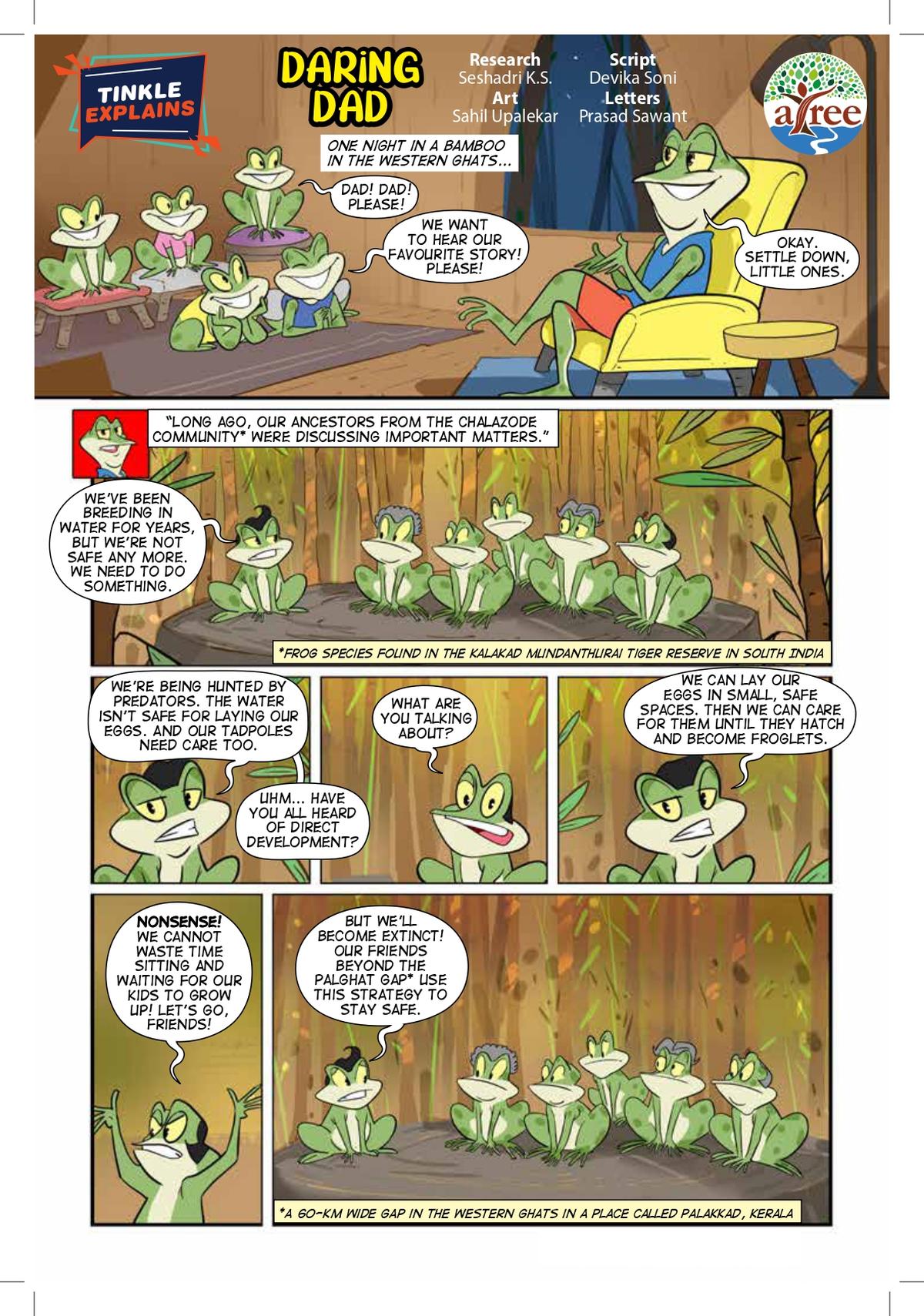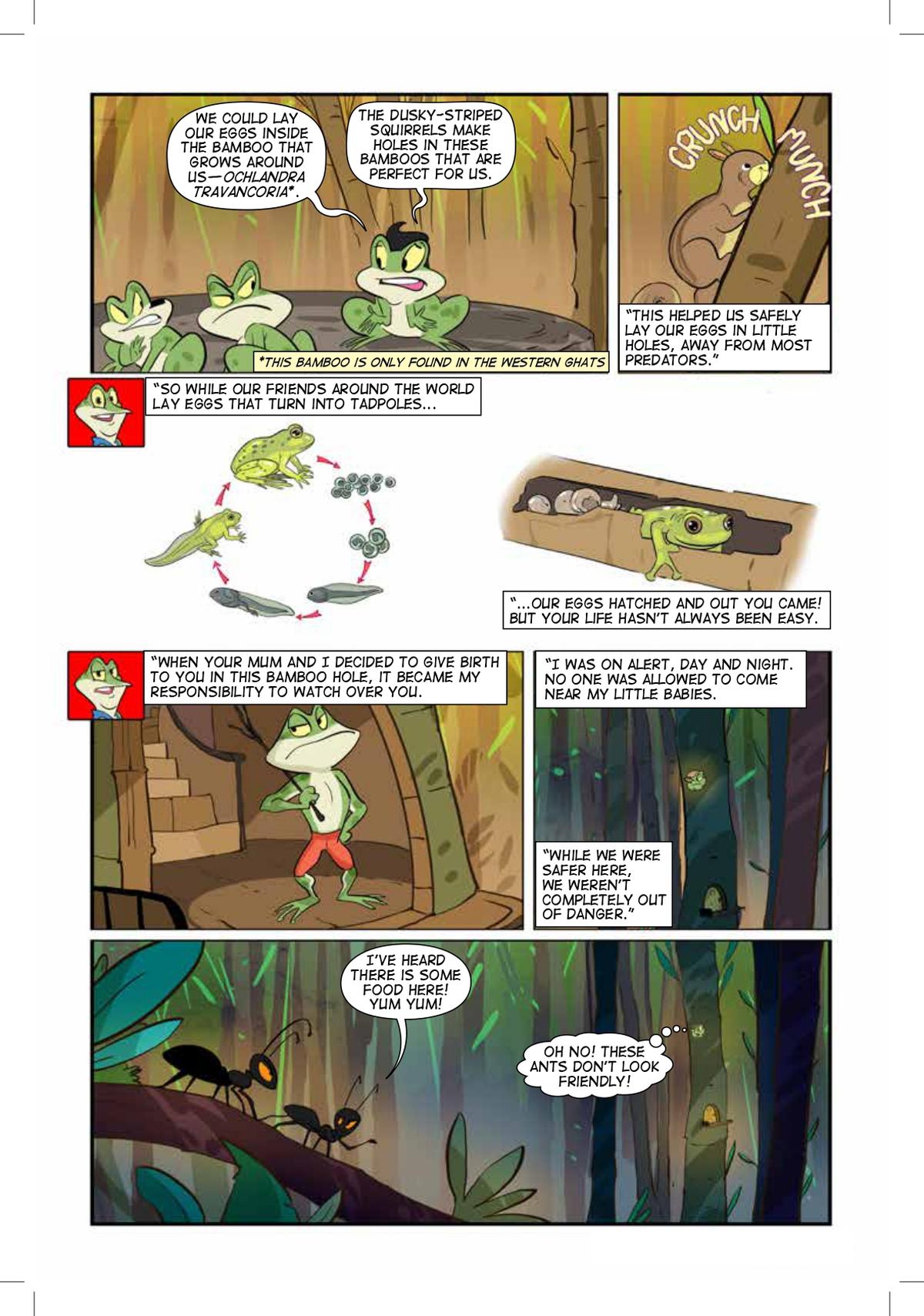Dr. Dimple Notani is a scientist with the National Centre for Biological Sciences (NCBS) studying gene regulation. But for the young readers of Tinkle Magazine, she is now a ‘superwoman’ who explains how an elephant, a monkey and a human are so different, and yet have DNA that is 98% similar.
Notani appears in the February edition of the children’s magazine as a character breaking down the science into fun, simple and intriguing information for children.
NCBS’s Tinkle magazine featuring Dimple Notani.
| Photo Credit:
SPECIAL ARRAGEMENT
Science is commonly perceived as ‘complex’, often leaving a gap between research and the general public. The notion often instills fear in children stopping them from pursuing it or even engaging with it. Institutions like NCBS and Ashoka Trust for Research in Ecology and the Environment (ATREE) have been collaborating with Tinkle to help break this barrier and make their research accessible and interesting for children.

Daring Chalazode frog dad.
| Photo Credit:
SPECIAL ARRAGEMENT
The non-preachy science
“Introducing children to science and scientific research was always on our cards,” says Jaya Peter, head of communications at ATREE. “This seemed to be a fun way to do it because comics don’t preach. It’s very easy to explain things in a comic format, and you can educate without sounding boring and teacherly.”
Peter remembers how as a children she believed one needed to be as brainy as Einstein to be a scientist. She believes comics are a great way to dispel this myth.
“We wanted to convey to the children that if you have a unique question and if you pursue it, that is all it takes. And we give examples of researchers who started their work that way.”
Featuring interesting characters each time – from Duggy, the very swaggy dung beetle, to the daring Chalazode frog dad to Mynah who educates her parents about invasive fish species – the ATREE team has worked with Tinkle to bring out the comics in the catchiest formats for children. Even the most popular Shikari Shambu makes cameo appearances, sometimes taking children out on safari, other times being schooled by a bee!

Daring Chalazode frog dad.
| Photo Credit:
SPECIAL ARRANGEMENT
No child’s play
While the comics may look fun and simple, the task at hand is often anything but that, notes Peter.
The communications team at ATREE interact with researchers to find story ideas that make for interesting comics. Discussions with the magazine team follow, a storyline and narrative evolve, and fact checks are done. It takes more than a month to finish one comic, Peter explains.
“Sometimes, we come across difficult subjects. For example, children have been told by adults that forests appear a particular way. So, when they look at a grassland, what they see may not be a forest, but a wasteland. There is also the problem of the content coming across as very preachy when we try to explain a certain concept.”
But when things get too difficult, ‘Shambu’ comes to the rescue!
“When we have a difficult subject, we use ‘Shikari Shambu’ because he’s very popular among children. We’d show a group of children going for a safari to a grassland with Shambu uncle. Those kinds of ideas help,” she notes.
According to Peter, ATREE is currently planning to bring out 10 such comics with the help of Tinkle.
Featuring women scientists
NCBS, on the other hand, has brought out nine comics in association with Tinkle so far and is in the process of bringing out the last in the series. The comics which started last year and appear every alternate month, feature women scientists working at the institution and their research.
“We wanted to highlight science, but through different women scientists who are working at NCBS,” says Rupsy Khurana, lead – science communication and outreach, at NCBS.
“The kind of research that NCBS does is very exclusive in some terms. We wanted to take these interesting stories of neuroscience or genetics or wildlife to children through interesting storytelling formats and I was looking for places for collaboration where the systems are already in place,” she recollects.
Tinkle, with its young reader base of around three lakh children, seemed the perfect fit and the team reached out to the magazine.
Given the number of women scientists working at the institution was far more than what could be featured in the comics, the team looked at research works that were relatively easier to explain. The comics deal with different topics such neuroscience, genetics, interactions between plants and organisms and so on, themes which children are familiar with to an extent.
“The idea was to not just talk about science, but to motivate children to read more science and engage in more science. We have highlighted the work happening in labs, but in some cases, also highlighted personal stories of the scientists, their journey, struggles, failures and successes.”
But why women scientists?
“We wanted to motivate children and specifically young girls,” Khurana says.
“Even today if you look at the proportion of women scientists it is very skewed. So, the idea was to show that anybody could do science. Ofcourse there will be challenges, but it is possible.”
Breaking it down
While the project to make their research accessible and engaging for children has been exciting for the scientists, translating complex ideas into a language children can easily understand has at times been a challenge.
The researchers at ATREE, for example, prepare a whole new presentation for their discussions with the Tinkle team, says Peter.
“They usually have a standard presentation that they give at conferences. But that won’t work for creative people or for children. So, we redo it. Certain researchers are very skilled at breaking it down. But there are a few who find it challenging.”
Notani of NCBS recollects how, on receiving the first draft of the comic from Tinkle based on her synopsis, she realised that there were a lot of jargons. ‘DNA code’ is a case in point.
“Code to you and me might mean something very different. A small child may understand it differently because coding in the sense of computer programming is very well known these days. That’s when we realised it’s much more challenging than we thought.”
She also notes that there is the challenge which arises in terms of the socio-economic background of the child.
“I come from an underprivileged background, and I studied in a Hindi medium government school. Comprehension of children coming from government school versus the private school can be very different. You don’t want to exclude these children by posing difficult language that probably they would never understand. But how do you bring these children into the mainstream? How do you get them excited about your science?” wonders Notani who believes the answer will become clearer only with more such initiatives.
The chain effect
Gayathri Chandrasekaran, Editor-in-Chief at Tinkle, notes that while the magazine has always carried pieces on science, environment and ecology, what is exciting about these comics is that they talk about research that is current and Indian.
“It is otherwise not accessible to the general public, much less children,” she notes.
“The thing with comics is that you can use it as a medium to talk about anything. Our target group is mainly children between 7 to 12. To write for a child, you have to dive into the heart of the matter and use simplicity to tell the story. So, we go through all the information, look at what is the best way to tell the story and see what bits would be exciting for the children.”
According to Chandrasekaran, the comics have received a very positive response from the readers. “Many have written saying they learned something new,” she says.
Notani also points out how the comic has had a chain-effect. After the magazine featuring her work was out, several people in her apartment complex reached out to her requesting one-to-one talks with their children.
“This way, I got a better opportunity to talk more about my work and explain things better. Many children asked me doubts that were not clear for them from the writeup.”
What about her own daughter? Notani laughs.
“I am not sure how much of the content my nine-year-old understood. But she was excited to see her own mother in Tinkle.”
Published – April 29, 2025 09:00 am IST







